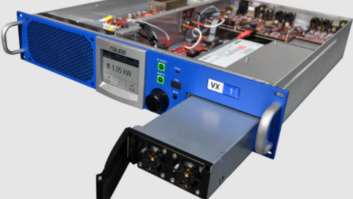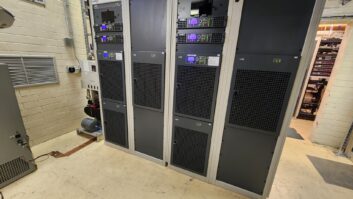Side by Side: Backup Power
Jun 1, 2012 1:30 AM
APC Smart-UPS
RT 2200VA RMCyberPower
OL2000RMXL2UStaco Energy
USCH-20001Superior Electric
SEG2000RInput Voltage90 – 15060 – 14260 – 14487 – 140Output (VA)2200200020002000Output (W)1600140016001400Backup Time (mins.)� � �Full Load6877� � �Half Load18191820Outlets6545CommunicationsRS-232, Smart Slot, USBRS-232, USB, EPO, opt. SNMPRS-232RS-232Extended BatteryYYYYWeight (lbs)60.637064.780.7Height2RU2RU2RU2RUModels in SeriesCabinet and rackmount (convertible), 120/208/240V input, 1kVa to 20kVa output120/240V input, 1kVa to 10kVa ouputCabinet and rackmount, 120/240V input, 1kVa to 3kVa outputCabinet and rackmount versions, 120/240V input, 1kVA to 6kVa outputMSRP$1,590$1,000$1,120$1,995URLapc.comcyberpowersystems.comstacoenergy.comsuperiorelectric.com
An uninterruptable power supply (UPS) is used for backup power, but the UPS term has become broad in its use to include systems that are not truly uninterruptable. There are essentially three types of battery-based backup power systems.
A standby system (often incorrectly called a UPS) provides power once the main feed is lost. There is a break in service of typically 2-4ms. The output of these devices is generally not a sine wave, but either a square wave or some quasi-sinusoidal waveform output. When the main feed is lost, a relay switches to the dc circuit and battery. Standby systems typically handle loads less than 1kVA.
A line-interactive system is still a standby device because there is a break in the power waveform, but they usually provide a sine wave or quasi-sine wave output with voltage regulation. These systems usually provide longer runtimes and can accept additional battery packs. They also commonly offer settings for input voltage ranges, battery management and system notifications. They typically start around 1kVA and handle up to 15kVA or more.
The true online systems are a real UPS. There is no break in the sine wave output. The batteries in these systems will last 3 to 5 years. These systems usually start at 1kVA and can handle single-phase and three-phase services. Because there is no break in the supply voltage, true online systems are ideal to cover computers and other devices that cannot tolerate a break in service.
A generator is a standby system in that there is a break in the supply voltage, although the output is a sine wave. A true online system can be used to cover the switchover period. Flywheel generators use a rotary flywheel effect to cover a break in supply voltage from commercial power to a UPS or generator.
With a generator or flywheel, the UPS itself may not need to carry the full load for an extended period of time. Assuming the backup system doesn’t fail, the UPS only needs to cover the switchover time and little more. Most systems offer a way to extend the battery life by adding additional power cell shelves as needed.
When the UPS is active, communications, such as RS-232, can provide status monitoring. This communication can also be used to initiate a shutdown in situations where the backup power has failed as well. In this case, computers and other devices can begin a shut-down process to protect themselves and prevent any loss of data.
We looked at true online systems to compare features and specs.
Model
June 2012
The Pick Hits of the 2012 NAB Show, new products from the 2012 NAB Show, KSBJ rebuilds, and Field Reports on the Yellowtec iXm and Aphex HeadPod 4….












